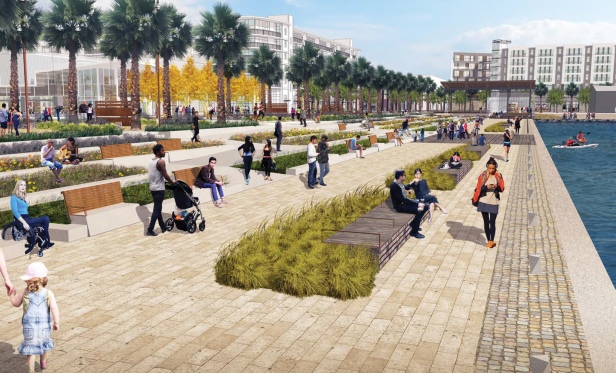
ALAMEDA, CA—The $1 billion mixed-use transit-oriented waterfront development at the gateway to Alameda Point is being developed by Alameda Point Partners. This joint venture is between Trammell Crow Residential, a division of Dallas-based Crow Holdings, srmERNST Development Partners, Madison Marquette, Eden Housing and financial partner Cypress Equity Investments.
In the second of a two-part exclusive, Bruce Dorfman, senior managing director of Trammell Crow Residential's Northern California division, recently discussed the ferry terminal, affordable housing and milestones of the mega project.
GlobeSt.com: How will the development fill the void in the existing transportation system?
Dorfman: It should be noted that we believe the new ferry terminal at Seaplane Lagoon is truly a game changer. It provides a very pleasant 20-minute commute into the city and it is right at our front door. With Bay Area freeways and BART service being over-burdened at peak commute times, the only practical way to expand mass transit is with ferry service. Further, the goal at Site A is to reduce dependency on the automobile by improving or providing alternative modes of transportation. Our project will encourage people to shift a greater share of their car trips to public transit, biking and walking. While Trammell Crow Residential's focus has been to develop in transit-oriented communities, this is the first time that we are going to create one, which is very exciting.
It cannot be overstated the commitment Site A is making to reduce automobile trips generated by our residents and users. Alameda Point Partners is making a considerable investment in transit infrastructure with a package of multi-modal strategies that complement and build off each other, including the new ferry terminal, bus rapid transit, last mile connection to BART (with shuttle service every 15 minutes in peak periods), bike and car sharing.
GlobeSt.com: How significant is it to get affordable housing included in the development?
Dorfman: The Bay Area is in tremendous need of additional housing at all levels of affordability: market rate, workforce and affordable. One of the mandates for this development is to build 25% of the residential units on Site A for affordable and workforce housing. This is higher than most cities require in the Bay Area. Working with Alameda Point Partners' nonprofit affordable housing partner, Eden Housing, our first phase will include 130 affordable units and provide housing for extremely low, very-low, low and moderate-income households. This will be constructed in two buildings on a central location on the site by Eden. One will be a family building with 70 units, while the second will be a senior building with 60 units. In addition, Trammell Crow Residential is working to build 70 units of teacher and staff housing similar to other apartment communities developed for the Santa Clara Unified School District and San Mateo Community College District. Also, Cypress Equity Investors, one of the buyers of land from Alameda Point Partners, is proposing to build a 200-unit project that offers 'affordability-by-design' to be appealing to moderate-income households. These projects are much in need and will reduce some of the pressures on the existing residents of Alameda.
GlobeSt.com: What type of infrastructure improvements are required to begin construction?
Dorfman: Some 30 acres of the 68-acre Site A parcel were transferred to Alameda Point Partners on March 16, 2018, and demolition was kicked off the following day. Construction will commence in the middle of this month on major infrastructure improvements including new water, sewer, electrical and gas lines, newly paved streets with bike and transit lanes, bulkhead improvements on Seaplane Lagoon as well as 8 acres of new parks. Where once stood old Navy facilities and heavy industrial equipment, there will be a mixed-use development complete with apartments, townhomes, parks and space for restaurants, retail, makers, R&D and office users.
The $500 million first phase of the Site A project is residential focused and consists of 673 housing units. Approximately 100,000 square feet of retail and maker space is also included in this phase, which will be geared toward resident-serving retail, dining and maker spaces, as well as community events and gatherings.
GlobeSt.com: What are the milestones expected for the project?
Dorfman: Completion of the new infrastructure for phase one of Site A is expected within the next two years, with vertical construction commencing by year end. The first residential units are projected to be completed in the second half of 2019. We are scheduled to move forward with the transfer of the second phase next year and would like to accelerate the acquisition of the third phase, but the timing is a function of the Navy's completion of its remediation activities. Besides adding more commercial space and jobs, the third phase is designed to have a hotel.
Alameda Point Partners is comprised of Trammell Crow Residential, a division of Dallas-based Crow Holdings, srmERNST Development Partners, Madison Marquette, Eden Housing and financial partner Cypress Equity Investments.
Want to continue reading?
Become a Free ALM Digital Reader.
Once you are an ALM Digital Member, you’ll receive:
- Breaking commercial real estate news and analysis, on-site and via our newsletters and custom alerts
- Educational webcasts, white papers, and ebooks from industry thought leaders
- Critical coverage of the property casualty insurance and financial advisory markets on our other ALM sites, PropertyCasualty360 and ThinkAdvisor
Already have an account? Sign In Now
*May exclude premium content© 2025 ALM Global, LLC, All Rights Reserved. Request academic re-use from www.copyright.com. All other uses, submit a request to [email protected]. For more information visit Asset & Logo Licensing.








